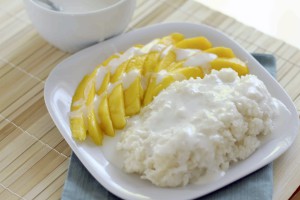This classic Thai dessert is so very delicious and memorable that you will find yourself serving it again and again, especially with spicy entrées and side dishes. In a recent cooking class, my students enjoyed sweet sticky rice with mango and zesty pumpkin soup, Thai-style peanut cabbage salad, Thai seared tofu and vegetarian curry. These dishes were seasoned with curry, cayenne, coriander, cilantro and garlic among other herbs and spices.
You can see why the softer and sweeter sticky rice with mango nicely complemented the zesty nature of the rest of the meal. Sweet sticky rice with mango is excellent in cold weather since it reminds us of the tropics, where the fruit grows in Latin climates such as Guatemala. Mangoes are readily available here in the U.S. and are sold in our winter season, so they should be easy to find. But, substituting guava, papaya or coconut would also be delicious.
Like all fruit, mangoes need to be ripe enough to eat. But contrary to what you might think, appearance can send you down the wrong road. A red hue can merely be an indication of too much sun. Smell and texture are the two best indicators of ripeness, especially around the stem which will rise slightly when the fruit is ripe Before it’s ripe, the stem remains flat. Color or appearance can be used as backup indicators, but plump, sweet-smelling mangoes are more reliable indicators of ripeness. After choosing your ripe mango, peel it with a small, sharp knife and cut slices of your juicy fruit about ¼-inch thick.
Be sure that your sticky rice is the type known as Japanese or sweet rice. It’s normally available with directions on the bag. A ratio of two cups of liquid to one cup rice is the normal proportion. This type of rice is easily made in
a medium size pot on your stove top. Place some fresh mango slices over the sticky rice and smother with a coconut sauce—it’s pure heaven. This is a very simple yet exotic dessert that you’ll truly enjoy. Specific ingredients and procedures to follow are noted below.
Sweet Sticky Rice with Mango
Serves 6 to 8
2 cups Thai sweet rice (also called sticky rice or sushi rice, available at Asian food stores)
4 to 5 ripe mangoes
8 tbsp brown sugar
½ tsp salt
2 cans good-quality (not light) coconut milk
3 cups water
1. To make the rice, soak the rice in 2 cups water for 20 to 30 minutes
2. Do not drain the rice. Add 1 cup more water plus 1 can coconut milk, ½ tsp salt and 2 tbsp brown sugar. Stir well.
3. Bring to a gentle boil, then partially cover with a lid (leaving some room for steam to escape). Reduce heat to medium-low.
4. Simmer in this way for 20 minutes or until coconut-water has been absorbed by the rice. Turn off the heat, but leave the pot on the burner with the lid on tight. Allow to sit for 5 to 10 minutes.
5. To make the sauce, warm (do not boil) the second can of coconut milk over medium to low heat (5 minutes). Add 3 tbsp sugar, stirring to dissolve.
6. Taste-test sauce for sweetness, adding more sugar if desired. (Note that it will taste less sweet when added to the rice although a ripe mango will bring more sweetness to the dish.)
7. When ready to serve, prepare the mango by slicing it open, dice or slice up the mango and place on top of rice.
8. Drizzle lots of the sweet coconut sauce over the mango and rice. It should look like an English pudding with custard sauce, with the rice swimming in sauce. Garnish with fresh mint and serve. (Note that the sauce recipe can be doubled for serving more than 8 guests.)
Please send comments, questions or observations of interest to Chef Alan at azox@zoxkitchen.com.

